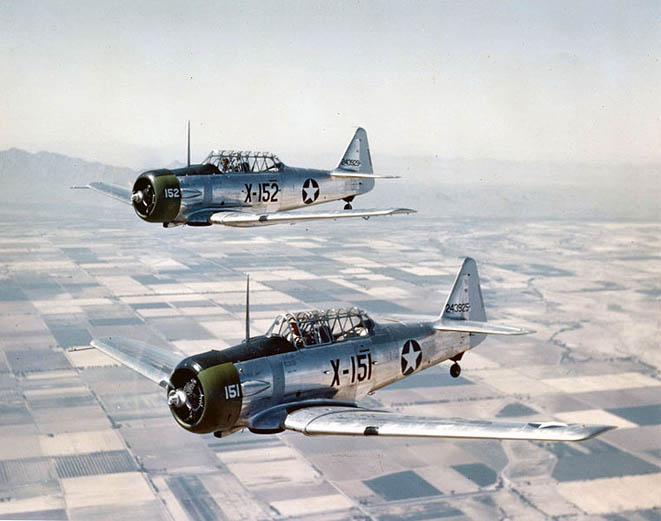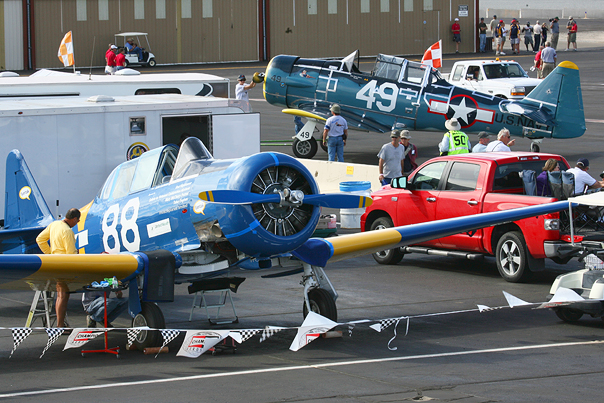CULPEPER
VIRGINIA- There was no mistaking the muscular roar of the big radial engine as
the most famous trainer to come out of World War II soared above this rural
Virginia town.
This year marks the 75th anniversary of the North American T-6
Texan, the big tandem-seat warbird in which countless pilots from dozens of
countries honed their flying skills.
This weekend, some 30 Texans will set
off from Culpeper, about 60 miles outside Washington, and fly up the Potomac
River, over the Pentagon and Arlington National Cemetery, to mark a unique
aeronautical milestone.
"There's a lot of history in this airplane. It trained so many air forces in
the world," said Len "Stoney" Stonich of the North American Trainer
Association, which represents owners, pilots and fans of the estimated 1,000
civilian-owned Texans around the world.
"They called it ‘the pilot-maker' because
if you can fly the T-6, you can be up in any World War II fighter and be
confident you can fly the airplane," he said.

-1943 AT-6 US Air Force iamge-
Known as the SNJ in its US Navy version, and the Harvard in Canada's air force, the Texan distinguished itself with its agile handling and aerobatic qualities as it prepared fighter pilots for combat in Europe and Asia. It remained in US military service through the Korean War in 1950-53 and into the Vietnam era -- and kept flying for many other air forces for even longer, until South Africa retired its fleet in 1995.
In its day, the Texan represented the cutting edge of aviation technology, a mere 35 years after the Wright brothers' first flight on a North Carolina beach. More than 20,000 were built, most of them in Texas -- hence the name -- of which more than 500 have been restored to flying condition in the US.

-T-6 pit at at Reno National Air Race Championship 2013, AlabamaAviator image-
With its 600-horsepower Pratt & Whitney Wasp radial engine, the Texan can fly 200 miles per hour as its pilots enjoy a commanding view of the skies above and the ground below from within a sliding glass canopy. Given how many were built, it remains the most popular of all World War II aircraft that turn heads at summer airshows all over North America.
The Culpeper Airfest will attract 70 vintage aircraft and an estimated crowd of 10,000 this weekend. It's also starred in the movies, playing the role of Japan's Mitsubishi Zero fighter "Tora! Tora! Tora!" -- a 1970 dramatization of the 1941 attack on Pearl Harbor that pulled the United States into the war.
Today, a mint-condition Texan can change hands for about $150,000, according to the aviation classified paper Trade-A-Plane. That's about half the price of a new Ferrari FF sports car -- but seeing how it burns 30 gallons of aviation fuel an hour, at $6 a gallon, operating costs add up.
"It's a millionaire's game," said retired airline pilot Andy Michalak, who owned a Texan when gas was cheaper and who still flies warbirds of all kinds for the Military Aviation Museum in Virginia Beach, Virginia. "It's guaranteed to make you broke and happy," added Mike Ginter, the coordinator of this weekend's fly-by over Arlington, who got his Texan a year to the day he retired from his US Navy pilot career.

-Aeroshell Aerobatic T-6 Team an airshow favorite, AlabamaAviator image-
The midday fly-by, in airspace normally restricted to commercial and active military aircraft, was initially set for Friday, but was postponed due to foul weather. Subject to the weather, it should take place on Saturday or Sunday.
Commercial pilot Dan Gleason enjoys the next best thing to owning a Texan -- flying the one that his employer owns, an experience he describes as deeply emotional and compelling, leavened with a powerful sense of history.
"My dad trained in one in World War II, so being able, what, 60 or 70 years later, to be flying the same plane... it's just a fun connection, a little hard to describe," he said. "It's a unique privilege for any aviator."
In lieu of a Texan, Culpeper Airfest founder Mike Dale owns a rare British-built Percival Provost trainer -- one of only four in the world today, and identical to the one in which he learned to fly as a teenaged Royal Air Force cadet 60 years ago. When he found it in his native England, "it was just a wreck, it had not flown in decades," said Dale, the retired head of Jaguar cars in North America, who had it shipped to the United States and painstakingly restored to full airworthiness in 1990.
FMI: http://www.culpeperairfest.com/, Staff report